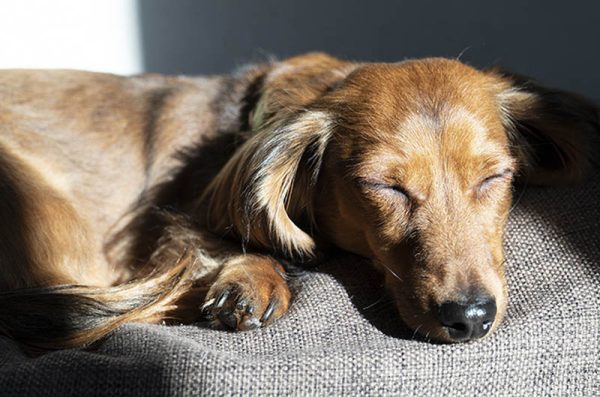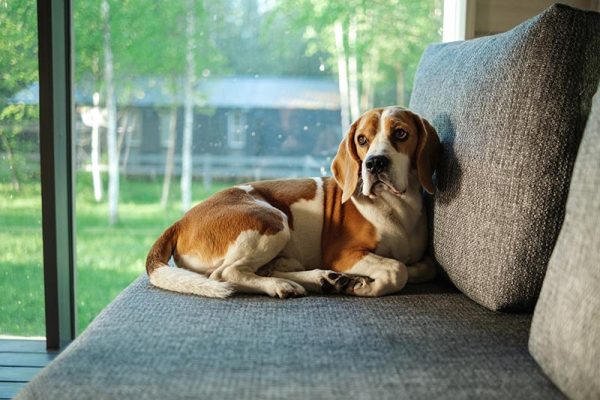The Siberian Husky breed was officially recognized in 1930. This beautiful dog is known for working in packs, pulling sleds across the snow. They’re energetic, friendly dogs that have various markings and eye colors. For a long time, people didn’t even know that they could own this dog as a pet. They assumed that Huskies were just working dogs. Along with this myth came many others. This well-loved dog is becoming more popular as a pet, but there are still many things that people don’t know about them. Today, we take a look at 10 of the most common myths and misconceptions about the Siberian Husky and put them to rest.

The 10 Siberian Husky Myths & Misconceptions
1. A Siberian Husky is part wolf.
The Siberian Husky resembles a wolf in coloring, coat, and body shape. Most people assume that the two are directly related. While all dogs are descendants of wolves, the Husky is no more closely related to the wolf than a Chihuahua or Bulldog. Huskies are domesticated dogs, and two Huskies breeding will result in more Huskies, not Huskies that are part wolf. For that to occur, a domestic Husky would have to directly breed with a wild wolf. Hybrid dogs do exist, where Huskies have been bred with wild wolves, but that is still not the same as a purebred Siberian Husky. Another big difference is diet. Wolves are obligate carnivores, meaning they survive solely on animal protein. They hunt and eat their prey. Siberian Huskies are omnivores, meaning they eat both meat and food derived from plants. Fruits, vegetables, and grains are often found in dog food, accompanying a sizable protein content.

- Related Read: 35 Siberian Husky Mixes
2. Siberian Huskies can’t live in warm climates.
When people think of Huskies, they usually think of a pack of dogs racing across a tundra while pulling a sled. There’s no doubt that Siberian Huskies are made for colder weather. They have the fur for it. A dense double-coat of protection helps them withstand the harshest winter weather conditions. Their paws pads also have veins that are much closer together than in the paw pads of other breeds. This helps keep the warm blood pumping in their feet and prevents them from freezing. But just because Huskies are built to survive the cold doesn’t mean they can’t live in warm weather. Huskies can adapt to warmer climates. In Siberia, summers are typically 70 degrees. While Huskies can survive Siberian winters, which can reach 30 degrees below zero, they also survive the summers just fine. In hot weather, though, activity should be restricted to keep them from overheating. Their double-coats can help them control their temperature and keep them cool, so it is not recommended that people shave them in the summer. It might seem helpful to get rid of all that fur, but they need that coat for temperature regulation. Shaving can actually increase their risk for heatstroke. Watch for signs of dehydration or heatstroke in your Husky or any other breed of dog during extremely hot weather.
3. A Siberian Husky needs to be shown who’s boss.
Thanks to movies like “Snow Dogs,” where a character is told to get his dog to obey him by biting the dog’s ear, Siberian Huskies are thought to be dogs that need dominating. They’re intelligent dogs that like to think for themselves, but that doesn’t mean they need dominance. Huskies respond to training done through positive reinforcement and a calm and firm demeanor. Consistency is key, and you can train these dogs with the proper methods that don’t include harming the dog to force them into submission.

4. Siberian Huskies are impossible to train.
Consistency is key when it comes to training Siberian Huskies. Huskies can be silly, acting like free spirits that can’t and won’t be told what to do. They want to play. They want to do what they want to do. A training session might not be what your dog wants to do at that moment, and they’ll let you know it. Don’t give in. With positive reinforcement, your intelligent Siberian Husky will learn to obey your commands. Perseverance will pay off in the end with these dogs. While the Husky is smart, they’re also stubborn. This doesn’t mean you have an untrainable dog. With confident consistency, Huskies can learn anything that you want to teach them.
- Related Read: Do Huskies Make Good Pets?
5. Siberian Huskies can’t live in apartments.
No matter the size of your home, your Husky is a social dog and doesn’t like to be left alone for long periods. They dislike being bored and will search for things to do if you’re not home. Not all of the things that they decide on will be desirable behavior. They can also be vocal, especially when they’re younger, and will bark or howl if left alone too long. For these reasons, people think that they can’t live in apartments. They can but it requires a little effort. These high-energy dogs need exercise. Dog parks or long brisk walks or runs will help them burn off this energy and not need to look for things to do on their own. If you’re going to work for long hours, consider a dog walker or dog daycare for your Husky to give them physical and mental stimulation and break up their day. Toys and treats to keep them busy will help them stay entertained in an apartment by themselves. No matter where you live, it can be a happy home for your Husky if you give them enough exercise and keep them from getting bored.

6. Siberian Huskies should live outside.
While Huskies may enjoy spending time outdoors, your companion animal should live inside the house with you. Just because they likely could live outside does not mean they should. Huskies are social and want the companionship of their people. They want to be a part of the family. Being separated from their family by being forced to live outside can cause separation anxiety, stress, and even injury. Their boredom and anxiety will force them to try to escape whatever enclosure that they’re in, destroy their living area, howl, or cause physical injuries to themselves. Huskies don’t want to be alone. Keeping them outside with other dogs won’t likely solve this problem either.
7. Siberian Huskies make excellent watchdogs.
This can be a reason that people want to keep them outside. They think that the Husky is a great protector. While Huskies do have an intimidating appearance and most people wouldn’t want to take their chances with a dog that resembles a wolf, the Husky is social and friendly. This is a dog that likes people and isn’t aggressive by nature. Your Husky is more likely to bring an intruder their toys to play with them rather than attack them. They aren’t usually suspicious of strangers and accept everyone as a friend. Huskies lack the attributes that would make them great watchdogs. Although they have the size and can look intimidating, they usually aren’t scary in the least.

8. Siberian Huskies only shed twice a year.
Shedding dogs usually shed their undercoats twice a year before changes in seasons, typically spring and fall. Winter coats are shed in the spring and summer coats are shed in the fall. This is also known as “blowing their coat.” This huge shedding process means you’ll find fur everywhere, constantly, for 3–5 weeks. With Huskies, they shed year-round. The coat-blowing happens twice a year, but you won’t be able to put the vacuum away the rest of the time. The shedding may not be as extreme as it is during the coat-blowing, but it will still happen. Be prepared for dog hair with a Husky.
9. Siberian Huskies are dangerous to children.
Any dog can be a danger to a child if they are improperly trained or socialized. This means Huskies that weren’t trained right or have a history of aggression could be a danger to not just children, but anyone. However, Huskies don’t make good watchdogs because they aren’t aggressive by nature. These dogs are social and friendly, wanting very much to be a part of a family. This includes children. Huskies are naturally loving and affectionate and tolerant of children. All dogs should be supervised and not left alone with young children, but Huskies aren’t a natural danger to them. As children grow up with a Husky, they can become good playmates for a dog that needs so much exercise.

10. Only real Siberian Huskies have blue eyes.
Siberian Huskies carry a gene that causes the loss of pigment in their irises. This makes their eyes appear blue. Husky puppies are born with blue eyes, but as the pigment darkens with age, their eye color can change into any number of combinations. Eye colors include brown, amber, blue, and even green. The combinations can vary as well. One eye can be one color and the other eye can be another. Sometimes, just part of one eye is blue while the rest is brown. Eye color doesn’t determine if your Siberian Husky is a pure breed, though. If your Husky has two brown eyes, they can still be a purebred dog.

Is a Siberian Husky Right for You?
A Siberian Husky makes a great family pet if you’re looking for a dog that is social, friendly, and good with kids. If you’re looking for a guard dog, they may not be the best choice for you. This is also a dog that requires a great deal of exercise to burn energy and keep from getting bored. If you can provide plenty of activity for your Siberian Husky and don’t mind constantly cleaning up dog hair, the breed could be an excellent choice for you.


What’s Bad About a Siberian Husky?
That depends on your idea of what makes a bad dog. Some frown upon the excessive shedding. This breed’s rowdiness as a puppy might also put off some people. Stubbornness, a strong will, and a lack of desire to be controlled mean it’ll take a little time to train your Siberian Husky, but it’s not impossible. Consistent patience and positivity are necessary to get your dog to obey you. Confinement also doesn’t work for most Huskies. If left outside alone, they will do whatever they can to escape their enclosure if they’re bored. Climbing a fence to get out and go on an adventure is not uncommon with these dogs. They have high prey drives, so if they see a small animal and want to chase it, not much can stand in their way.
Unfortunately, since many people get Siberian Huskies based on their looks and don’t really understand what goes into owning one, Huskies often find themselves in rescues. If you’re looking for this breed, check your local rescues and shelters or find a Siberian Husky breed-specific rescue in your area. These dogs deserve someone who understands their needs, and you can save a life.

Final Thoughts
We hope that our list of Siberian Husky myths and misconceptions has eased your mind if you’re considering adding this dog to your family. There are plenty of things that are amazing about this breed, and a few unfounded rumors shouldn’t keep you from experiencing such a loyal and loving companion. With the right training and exercise, you can provide your dog a wonderful life. Whether you’re an apartment-dweller in a fast-paced urban setting or living in a farmhouse in the country, your Siberian Husky can be happy. Meeting their physical needs is important, but this is a dog that wants your love and companionship the most. If they can be with you anywhere, they’ll be content.
You may also be interested in:
- 7 Best Toys for Huskies: Reviews & Top Picks
- Do Huskies Make Good Service Dogs? What You Need to Know!
Featured Image Credit: Ovidiu Constantin Moraru, Shutterstock



















